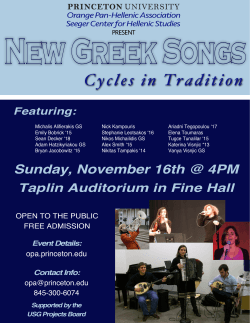
Elegant Connections in Physics
ELEGANT CONNECTIONS IN PHYSICS "LIGHT PAINTING CAN BE FUN," by William Cho. Created using blue, orange, and violet cellophane wrapped around a f lashlight during a 30-second exposure. Made available under an Attribution-NonCommercial-ShareAlike 2.0 Generic license. 26 Fall 2014 / The SPS Observer The Museum of by Dwight E. Neuenschwander, Southern Nazarene University, Bethany, OK Light Forty thousand years ago the bear and the boar were painted on cave walls by torchlight. Two hundred years ago Lakota grandchildren gathered around campfires under starry skies to listen as grandfathers told tales of the Star People. The Odyssey, the Principia, and Eine Kleine Nachtmusik were written by f lickering candlelight. By sunlight or by lamplight, in a world lit only by fire, for ages beyond memory humanity worked by light. “By sunlight or by lamplight, in a world lit only by fire, for ages beyond memory humanity worked by light.” In a world now lit by dynamos and quanta, we also work with light. Precise and powerful, versatile and beautiful, light has been shaped to fit our grasp. Radar and lasers, CDs and DVDs and LEDs, spectroscopy, adaptive optics, medical imaging, optical computers—light reads bar codes, analyzes stars, opens doors, guides missiles, and attaches loose retinas. The signal fire has become the satellite array; light carries voices across continents through wispy fibers of glass. Light delivers an image of the Earth, our blue speck, as seen by Voyager from beyond the orbit of Pluto. Light heals and informs. Light is also a weapon and a trespassing pollution, which says little about light itself but much about human fear and desire. In literature, light and darkness set the mood. In the sacred books of ancient wisdom, light symbolizes insight and serenity. To walk in the light is to bring out the best in our humanity. Creation mythologies begin with light, but light as a tool is our creation. As we begin 2015, designated the International Year of Light and Light-Based Technologies by the United Nations, let us celebrate the physics of light and the technologies it spawns. May we be sufficiently enlightened to look beyond ourselves, to use the power and promise of light with care and responsibility. While it cuts steel and sends messages, may light be a tool used always for enhancing our humanity. I am the one who openeth his eyes, and there is light; When his eyes close, darkness falleth. —Utterance of the Egyptian god Ra, Turin papyrus, ca. 1300 BC. The lights of nature and of mind entwine within the eye and call forth vision. Yet separately, each light is mysterious and dark. Even the brightest light can escape our sight . . . . Two lights brighten our world. One is provided by the sun, but the other answers to it—the light of the eye. Only through their entwining do we see; lacking either, we are blind. —Arthur Zajonc, Catching the Light: The Entwined History of Light and Mind (Oxford University Press, Oxford, UK, 1993), pp. 1–3. In the forward of the book of photos by Páll Stefánsson, Light: Images of Iceland, (Iceland Review, Reykjavik, Iceland, 1987), the editor quotes Genesis 1:1, then says: The light was good. And over the aeons since creation, everything has changed but the light, that remains good as ever. Man, too, has worshipped the light since time immemorial, as everything in nature does in its own way. In his unceasing quest The SPS Observer / Fall 2014 27 ELEGANT CONNECTIONS IN PHYSICS “What!” exclaimed the Ghost. “Would you so soon put out, with worldly hands, the light I give? Is it not enough that you are one of those whose passions made this cap, and force me through whole trains of years to wear it low upon my brow!” —from Charles Dickens, Christmas Stories by Charles Dickens (Nelson Doubleday, Garden City, NY, 1955). WHITE LIGHT goes through a prism lying on a black background, refracting into spectral colors. Photo by iStock.com/joephil. back to himself and his origins, rational man has followed paths through the valley of darkness. Yet he knows that eternal truth cannot be found in the dark. Symbolically, man is always searching for the light. Truth is within the light- because life itself is light . . . A vital urge leads Man to bask in the light. . . . What is Life? It is a flash of a firefly in the night. It is the breath of a buffalo in the winter time. It is the little shadow which runs across the grass and loses itself in the Sunset. —Crowfoot, warrior and orator of the Blackfoot Confederacy (1821–1890), spoken in the last hours of his life. Source: Ethel Brant Monture, Canadian Portraits: Brant, Crowfoot, Oronhyatekha—Famous Indians (Clarke, Irwin, & Co., Ltd., Toronto, p. 120, 1960). . . . Then Allan a Dale came forth and tuned his harp, and all was hushed around, and he sang in his wondrous voice songs of love, or war, of glory, and of sadness, and all listened without a movement or a sound. So Allan sang till the great round silver moon gleamed with its clear light amid the upper tangle of the mazy branches of the trees . . . —from Howard Pyle, The Merry Adventures of Robin Hood of Great Renown in Nottinghamshire (Scribner's Sons, New York, 1883). . . . But the strangest thing about it was, that from the crown of its head there sprung a bright clear jet of light, by which all this was visible; and which was doubtless the occasion of its using, in its duller moments, a great extinguisher for a cap, which it now held under its arm . . . Perhaps, Scrooge could not have told anybody why, if anybody could have asked him; but he had a special desire to see the Spirit in his cap; and begged him to be covered. 28 Fall 2014 / The SPS Observer This master, meanwhile, bending over a vast manuscript adorned by grotesque paintings, appeared to be tormented by an idea which incessantly obtruded itself upon his meditations . . . “Yes, so Manou asserted and Zoroaster taught. The sun is the offspring of fire, and the moon of the sun; fire is the soul of the universe. Its elementary atoms are incessantly overflowing and pouring upon the world in innumerable currents. At the points where these currents intersect one another in the atmosphere they produce light; at their points of intersection in the earth they produce gold. Light, gold—the same thing! . . . But how is science to set about detecting the secret of this general law? Why, this light which floods my hand is gold! These same atoms, which expand according to a certain law, need but be condensed according to a certain other law. How is this to be done? Some have proposed to effect it by burying a ray of the sun. Averroës—yes, it was Averroës—buried one under the first pillar on the left, in the sanctuary of the Koran, in the grand mosque at Cordova; but the vault must not be opened to see whether the operation has been successful for the space of eight thousand years. . . .” “Others have thought,” continued the archdeacon, “that it would be better to operate upon a ray of Sirius. But it is very difficult to obtain one of his rays pure, on account of the simultaneous presence of the other stars, whose light mingles with it . . .” —from Victor Hugo, The Hunchback of Notre Dame, translated by Walter J. Cobb (New American Library, New York, 1965), pp. 264–265. Then I placed another Prisme . . . so that the light . . . might pass through that also, and be again refracted before it arrived at the wall. This done, I took the first Prisme in my hand and turned it to and fro slowly about its Axis, so much as to make the several parts of the Image . . . successively pass through . . . that I might observe to what places on the wall the second Prisme would refract them. When any one sort of Rays hath been well parted from those of other kinds, it hath afterwards obstinately retained its colour, notwithstanding my utmost endeavours to change it. —Isaac Newton, Optiks (1666). The light of the Sun appears to be yellow. Thus it is necessary that the Sun projects by its nature more yellow rays than others, ... Mr. Newton has shown in his Optics, page 216, that sunlight is abundant in this kind of ray. It is very possible that in other systems, there are suns which project more rays of red, green, etc. and that the primary colors of suns that we never see are different from ours, and that, in short, there are in Nature other colors than those that we know of in our world. —Gabrielle-Emilie Le Tonnelier de Breteuil, Marquise du Châtelet, Pièces qui ont remporté le prix de l’académie royal des sciences de Paris (1738), pp. 165-166. Later published in Dissertation sur la Nature et la Propagation du Feu (1744). All the fifty years of conscious brooding have brought me no closer to the answer to the question, “What are light quanta?” Of course today every rascal thinks he knows the answer, but he is deluding himself. —Albert Einstein, 1951 It would appear that, since the electron and positron are distinguishable, the Pauli principle would not require the interchange diagram, leaving as the only one [the following]. which would represent virtual annihilation of the electron and positron, with the photon later creating a new pair. It turns out that it is necessary to regard an electron–positron pair as existing part of the time in the form of a virtual photon in order to obtain agreement with experiment. —Richard Feynman, Quantum Electrodynamics (W. A. Benjamin, New York, 1961). Even Light itself, which every thing display, Shone undiscovered, till his brighter mind Untwisted all the shining robe of day; And, from the whitening undistinguished blaze, Collecting every ray into his kind, To the charmed eye educed the gorgeous train Of parent colours. —James Thomson, "A Poem Sacred to the Memory of Sir Isaac Newton." ANOTHER FEYNMAN DIAGRAM. Public domain image. There are two ways of spreading light . . . To be the candle, or the mirror that reflects it. —Edith Wharton, "Vesalius in Zante," Artemis to Actaeon and Other Verse (Scriber, New York, 1909). Seeing into darkness is clarity. Knowing how to yield is strength. Use your own light and return to the source of light. This is called practicing eternity. —Lao-tzu, Tao Te Ching, translated by Stephen Mitchell (Harper & Row, New York, 1988), p. 52. When the rainbow, opposite the sun A thousand intermingled colors throws With saffron wings then dewy Iris flies Through heaven’s expanse, a thousand varied dyes Extracting from the sun, opposed in place. —Virgil Nothing can dim the light which shines from within. —Maya Angelou A FEYNMAN DIAGRAM illustrates the interactions of subatomic particles. Public domain image. But it is still possible by the same phenomenological reasoning to conceive of the [next diagram], Nay then, the sun shall bide behind my shoulders! The cataract, that through the gorge doth thunder I’ll watch with growing rapture, ‘mid the boulders From plunge to plunge down-rolling, rent asunder In thousand thousand streams, aloft shower Foam upon hissing foam, the depths from under. Yet blossoms from this storm a radiant flower; The SPS Observer / Fall 2014 29 ELEGANT CONNECTIONS IN PHYSICS The painted rainbow bends its changeful being, Now lost in air, now limned with clearest power, Shedding this fragrant coolness round us fleeing. Its rays an image of man’s efforts render; Think, and more clearly wilt thou grasp it, seeing Life in the many-hued, reflected splendour. —J. W. von Goethe, Faust, translated by Albert G. Latham (E. P. Dutton, New York, 1908), Pt. II, p. 15. . . .“And you, Ring-bearer,” she said, turning to Frodo. “I come to you last who are not last in my thought. For you I have prepared this.” She held up a small crystal phial: it glittered as she moved it, and rays of white light sprang from her hand. “In this phial,” she said, “is caught the light of Eärendil’s star, set amid the waters of my fountain. It will shine still brighter when night is about you. May it be a light to you in dark places, when all other lights go out. Remember Galadriel and her Mirror!” Frodo took the phial, and for a moment as it shone between them, he saw her again standing like a queen, great and beautiful, but no longer terrible. He bowed, but found no words to say . . . . . . At length they came to the door upon the outer court, and they halted. Even from where they stood they felt the malice of the Watchers beating on them, black silent shapes on either side of the gate through which the glare of Mordor dimly showed. . . . Sam drew out the elven-glass of Galadriel again. As if to do honour to his hardihood and to grace with splendour his faithful brown hobbit-hand that had done such deeds, the phial blazed forth suddenly, so that all the shadowy court was lit with a dazzling radiance like lightning . . . The will of the Watchers was broken with a suddenness like the snapping of a cord, and Frodo and Sam stumbled forward. Then they ran. . . . —J.R.R. Tolkien, The Fellowship of the Ring (Houghton Mifflin Company, Boston, MA, 1965) and The Return of the King (Houghton Mifflin Company, Boston, MA, 1965). We've all got both light and dark inside us. What matters is the part we choose to act on. That's who we really are. —J.K. Rowling, Harry Potter and the Order of the Phoenix (Scholastic, New York, 2003). On the first morning of his imprisonment when he got up early, went out of the shed at dawn and saw the cupolas and crosses of the Novodevichy convent, still dark at first, and saw the hoarfrost on the dusty grass, the hummocks of the Sparrow Hills, the wooded banks above the winding river vanishing into the purple distance; when he felt the touch of the fresh air and heard the jackdaws flying from Moscow across the fields; and when later the light gushed out of the cloud and the cupolas, crosses, hoarfrost, the river and the distant horizon all began to sparkle in the joyous light—Pierre experienced a new feeling he had never known before of strength and exultation in life. —Leo Tolstoy, War and Peace, translated by Ann Dunnigan (New American Library, New York, 1968), p. 1209. It is well known that Maxwell’s electrodynamics—as usually understood at present—when applied to moving bodies, lead to asymmetries that do not seem to be inherent in the phenomena. Take, for example, the electrodynamic interaction 30 Fall 2014 / The SPS Observer between a magnet and a conductor. The observable phenomenon here depends only on the relative motion of the conductor and the magnet, whereas the customary view draws a sharp distinction between the two cases, in which either the one or the other of the two bodies is in motion . . . Examples of this sort, together with the unsuccessful attempts to detect a motion of the earth relative to the “light medium,” lead to the conjecture that not only the phenomena of mechanics but also those of electrodynamics and optics will be valid for all coordinate systems in which the equations of mechanics hold . . . —Albert Einstein, “Zur Elektrodynamik Bewegter Körper,” Annalen der physik 17, 1905; English translation, “On the Electrodynamics of Moving Bodies,” edited by John Stachel, Forward by Roger Penrose, Einstein’s Miraculous Year: Five Papers that Changed the Face of Physics (Princeton University Press, Princeton, NJ, 1998), pp. 123–124. The wave theory of light, which operates with continuous spatial functions, has proved itself superbly in describing purely optical phenomena and will probably never be replaced by another theory. One should keep in mind, however, that optical observations refer to time averages rather than instantaneous values; and it is quite conceivable, despite the complete confirmation of the theory of diffraction, reflection, refraction, dispersion, etc., by experiment, that the theory of light, operating with continuous spatial functions, leads to contradictions when applied to the phenomena of emission and transformation of light. Indeed, it seems to me that the observations of “black-body radiation,” photoluminescence, production of cathode rays by ultraviolet light, and other related phenomena associated with the emission or transformation of light appear more readily understood if one assumes that the energy of light is discontinuously distributed in space. According to the assumption considered here, in the propagation of a light ray emitted from a point source, the energy is not distributed continuously over ever-increasing volumes of space, but consists of a finite number of energy quanta localized at points of space that move without dividing, and can be absorbed or generated only as complete units. —Albert Einstein, English translation, “On the Heuristic Point of View Concerning the Production and Transformation of Light,” edited by John Stachel, Forward by Roger Penrose, Einstein’s Miraculous Year: Five Papers that Changed the Face of Physics (Princeton University Press, Princeton, NJ, 1998), p. 178. I spent 10 years of my life testing [the photon concept and] the 1905 equation of Einstein’s, and, contrary to all my expectations, I was compelled in 1915 to assert its unambiguous experimental verification in spite of all its unreasonableness since it seemed to violate everything we knew about the interference of light. —R. A. Millikan, "Albert Einstein on his seventieth birthday," Rev. Mod. Phys. 21, 343–345 (1949). Since the presence of fire-corpuscles alone does not suffice to excite heat, but their motion is needed also, it seems to me that one may very reasonably say that motion is the cause of heat. . . . But I hold it to be silly to accept that proposition in the ordinary way, as if a stone or piece of iron or a stick must heat up when moved. The rubbing together and friction of two hard bodies, either by resolving their parts into very subtle flying particles or by opening an exit for the tiny firecorpuscles within, ultimately sets these in motion; and when they meet our bodies and penetrate them, our conscious mind feels those pleasant or unpleasant sensations which we have named heat, burning, and scalding. And perhaps when such attrition stops at or is confined to the smallest quanta, their motion is temporal and their action calorific only; but when their ultimate and highest resolution into truly indivisible atoms is arrived at, light is created. —Galileo, “The Assayer,” Discoveries and Opinions of Galileo, translated by Stillman Drake (Doubleday & Co., New York, 1957), p. 278. Let me imagine, and at the moment it is nothing but imagining, an idealized, abstract physical situation in which I will create a particle [at the position x at time t] . . . And let me describe this act of creation . . . by a creation operator [this is labeled by the space-time point xj and that operates on this state]. An operator because it symbolizes a physical property but something beyond what we are accustomed to thinking of, and an operator because it acts on a state, the state being the state in which nothing is present, or physically a vacuum. We now transfer our attention to this operator as the basic physical object. And this is what I mean by the quantized field because it is on the one hand a field; it is a mathematical quantity which varies continuously in time and space. On the other hand, it is certainly not a classical field, be- cause these as operators are not things that can be measured simultaneously, and [also because] in the operator character . . . we have the elements of discontinuity which is essentially the particle concept. —Julian Schwinger, quoted by Silvan Schweber, QED and the Men Who Made It: Dyson, Feynman, Schwinger, and Tomonaga (Princeton University Press, Princeton, NJ (1994), pp. 362–363. . . . . According to this hypothesis, then, an atom is a sort of infinitesimal solar system whose members, the electrons, are no bigger with respect to the diameter of the atom than is the earth with respect to the diameter of the earth’s orbit. Furthermore, according to this hypothesis, it is the vibrations of these electrons which give rise to light and heat waves . . . This theory undoubtedly contains many germs of truth. As yet, however, it is in the formative stage and ought to be regarded as a profoundly interesting speculation brought forward by men high in authority in the scientific world, rather than as an established doctrine. However, that such things as negatively charged corpuscles exist, and that they have a mass which is much smaller than that of an atom is now universally admitted . . . . . . X rays are like cathode rays in producing fluorescence, . . . [and] X rays are not deflected either by a magnet or by an electrostatic charge, nor do they carry electrical charges of any sort. Hence it is certain that they do not consist, like cathode rays, of streams of electrically charged particles. Their real nature is still unknown, but they are at present generally regarded as irregular pulses in the ether, set up by the sudden stopping of the cathode-ray particles when they strike an obstruction. —Robert A. Millikan and Henry G. Gale, A First Course in Physics (Ginn & Company, New York, 1906), pp. 474–475. . . . For several years after the laser’s invention, colleagues used to tease me about it, saying, “That’s a great idea, but it’s a solution looking for a problem.” The truth is, none of us who worked on the first lasers imagined how many uses there might eventually be. —Charles H. Townes, "The Light That Shines Straight," Beamline, Summer/Fall 2000. Every picture has its shadows And it has some source of light —Joni Mitchell, “Shadows and Light” (1990). And when the night is cloudy, there is still a light that shines on me. Shine until tomorrow, let it be. —John Lennon and Paul McCartney, “Let it Be” (1970). // www.light2015.org The SPS Observer / Fall 2014 31
© Copyright 2025
















